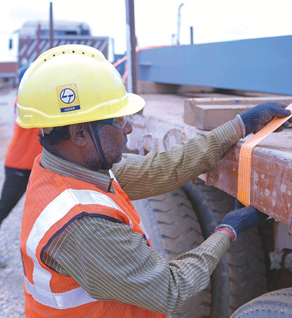Risk-based competency assurance & training to improve EHS performance, the B&F way


I realized for the first time the importance of anchoring independent lifelines when dismantling scaffolds, using personal restraint systems and the limitations on Personal Protection Equipment (PPE) based on free fall distances and other factors.
Suryadev Singh
Scaffolder


25-year-old Suryadev Singh at B&F IC’s Exide Energy project site feels that he is now better equipped in his scaffolding trade than ever before. When he joined the site, he was pleasantly surprised to be grilled by the Formwork In-charge to ascertain his skillsets and competency. “Thereafter, I was trained how to use personal fall protection devices which is when I realized for the first time the importance of anchoring independent lifelines when dismantling scaffolds, using personal restraint systems and the limitations on Personal Protection Equipment (PPE) based on free fall distances and other factors.” Certainly, Suryadev is now a wiser man as also are Satish, a 44-year-old rigger and 49-yearold Chotelal, a gas-cutter.

The training taught me the need for monitoring gas in confined spaces before each entry, periodically thereafter and the importance of inspecting gas cutting hoses, flash back arrestors and torches with more care when working inside confined spaces.
Chotelal
Gas Cutter


A delighted Satish was able to answer all the questions posed to him about rigging techniques by the Mechanical In-charge when he joined the site. Later, a half-day training session on ‘Riggers & Signalmen’, proved to be eye-opener for him. “I learnt that loads can be marked with stickers considering their Centre of Gravity, length and breadth thereby avoid a trial & error method to determine the slinging point,” he shares with a sense of wonder. A training session on ‘Working in Confined Spaces’ taught Chotelal the reasons as to why accidents occur during gas cutting that he has seen enough during his 30 years’ experience. “The training taught me the need for monitoring gas in confined spaces before each entry, periodically thereafter and the importance of inspecting gas cutting hoses, flash back arrestors and torches with more care when working inside confined spaces.”

I learnt that loads can be marked with stickers considering their Centre of Gravity, length and breadth thereby avoid a trial & error method to determine the slinging point.
Satish
Rigger


Evolving & benchmarking the training process
These are success stories of workers who have been empowered with adequate knowledge and training to perform their tasks more efficiently and safely. “Risk-based competency assurance and training involve systematically assessing skills, knowledge, and abilities of workmen, especially those in safety critical roles, to mitigate potential risks associated with their tasks,” explains P Nagarajan, Head – EHS, HRC SBG, B&F IC.


Risk-based competency assurance and training involve systematically assessing skills, knowledge, and abilities of workmen, especially those in safety critical roles, to mitigate potential risks associated with their tasks.
P Nagarajan
Head – EHS, HRC SBG, B&F IC

To begin with, the EHS team identified 4 safety critical roles – riggers, scaffolders, gas cutters and signalmen
– to develop a risk-based competence assurance & training module. “Since neither the government nor the Indian construction industry had a competency assessment and certification on the lines of UK’s Construction Industry Training Board, we decided to develop our own processes for competency assessment,” points out M Nachiappan, Senior Deputy General Manager (EHS), B&F IC. “The earlier method of a simple interview process by the respective site engineers was subjective, inconsistent and individual oriented so we analyzed and benchmarked our process with international organizations such as CITB UK, and the National Skill Development Council India Qualification packs.”

Since neither the government nor the Indian construction industry had a competency assessment and certification on the lines of UK’s Construction Industry Training Board, we decided to develop our own processes for competency assessment.
M Nachiappan
Senior Deputy General Manager (EHS), B&F IC



The modus operandi
An assessment checklist with very clear objective questions was developed for each of the four chosen trades and the candidate’s performance is ranked on a scale of 2 to 10 for each of the questions.
Based on the overall score they are categorized as:
- Skilled (180–125)
- Semi-skilled (124–75) or
- Unskilled (Below 75)
“This process ensures consistency in evaluation, quantified assessment and identification of strength and weakness, and the outcome process is recorded in our digital application WISA to easily monitor workmen movement across projects and avoid repetition”, explains Mohammad Moizuddin, Head – EHS, PAF SBG, B&F IC.

This process ensures consistency in evaluation, quantified assessment and identification of strength and weakness, and the outcome process is recorded in our digital application WISA to easily monitor workmen movement across projects and avoid repetition.
Mohammad Moizuddin
Head – EHS, PAF SBG, B&F IC


To keep a good thing going, standardized training modules were developed and deployed IC-wide covering operators & drivers, riggers and signalmen, those working in confined spaces and how to use personal fall protection devices.
Standardized training modules – a few salient features
- Defined learning outcome, as per which workers are evaluated
- Comprehensively covers all the salient topics based on international benchmarks with practical demonstrations
- Mode is video based & pictorial with actual implementation photos from projects
- Is available both in Hindi and English
- Post training evaluation
- Training for the trainers – who are provided with a detailed guide to reinforce the intent behind each slide and suggested approach for each topic. These sessions bring consistency in training delivery and effectiveness across the locations. 100+ trainers have already been trained.
The numbers are beginning to show
Nachiappan is a happy man for their module is making a marked difference on ground. “We have already covered close to 100% of our workforce in the 4 chosen trades,” he beams.
- 2332 Riggers & Signalmen
- 2445 Scaffolders
- 385 Workmen engaged in confined spaces
- 20,466 Workmen on use of Personal Fall Protection Devices
“We are administering and monitoring the training on WISA with all the pre and post training scores of workmen recorded in the App,” he shares, that helps to track their details by merely scanning the QR code for information such as training attended date, score obtained, due for training, etc.
With such success, Nagarajan, Moizuddin, Nachiappan & team are now considering how to increase the width and depth of this training module that is already significantly improving EHS performance.